The Development Trend and Research Frontiers of Distributed Hydrological Models—Visual Bibliometric Analysis Based on Citespace
Abstract
1. Introduction
2. Data Collection and Method
2.1. Data Collection
2.2. Method
3. Results and Discussion
3.1. Time Analysis of Post Volume
3.2. Cooperation Network Analysis
3.3. Co-Occurrence of Discipline Categories
3.4. Co-Citation Analysis
3.5. Keywords Co-Occurrence and Burst
4. Conclusions
4.1. Summary
4.2. Outlook
- (1)
- Obtain high-precision and high-resolution data. Hydrological phenomena exhibit different hydrological characteristics at different spatial scales. Improving the accuracy and resolution of hydrological data is an effective method to reveal hydrological processes at different scales. With the continuous deepening of hydrological simulation in mountainous and alpine regions, there is an urgent need for high-resolution rainfall data as driving data for distributed hydrological models. At present, the integration of related technologies (such as GIS, remote sensing technology) and products with distributed hydrological models has become an important means to obtain high-precision data and to improve the accuracy of hydrological models to simulate hydrological processes. Therefore, in order to improve the accuracy of simulation of hydrological processes, it is an inevitable trend in the field to develop new technologies and products and improve the degree of coupling with distributed hydrological models.
- (2)
- Development of distributed hydrological models suitable for alpine regions. As the cumulative effect of climate warming has continued in the past ten years, the global cryosphere has shown a trend of accelerated change. Climate change has led to the melting of glaciers, and changes in the vertical distribution of permafrost and vegetation which inevitably have an impact on the hydrological processes of the basin [59]. Therefore, the study of hydrological processes in the global cryosphere and alpine regions has become more and more important. At present, most of the research and development of hydrological models is for large and medium-sized noncryosphere basins. These models are not easily applied to alpine regions. Therefore, the development of models suitable for alpine regions is very important to further explore the hydrological processes in alpine regions, and it is also a trend in the field of hydrological model research.
- (3)
- The response of hydrological processes to climate change. Sohoulande et al. (2020) stated that under climate change, most predictions show that the terrestrial hydrological cycle has been severely disturbed, which affects the availability of freshwater resources [60]. Therefore, under the continuous influence of climate warming, the response of hydrological processes to climate change will become an important research direction in the field, and the coupling of meteorological models and hydrological models has also become an important means to explore the response of hydrological processes to climate change.
Author Contributions
Funding
Institutional Review Board Statement
Informed Consent Statement
Data Availability Statement
Acknowledgments
Conflicts of Interest
Abbreviations
References
- Li, B.J.; Chen, D.X.; Wu, S.H.; Zhou, S.L.; Wang, T.; Chen, H. Spatio-Temporal Assessment of Urbanization Impacts on Ecosystem Services: Case Study of Nanjing City, China. Ecol. Indic. 2016, 71, 416–427. [Google Scholar] [CrossRef]
- Remondi, F.; Burlando, P.; Vollmer, D. Exploring the Hydrological Impact of Increasing Urbanisation on a Tropical River Catchment of the Metropolitan Jakarta, Indonesia. Sustain. Cities Soc. 2016, 20, 210–221. [Google Scholar] [CrossRef]
- Wu, L.; Su, X.; Ma, X.; Kang, Y.; Jiang, Y. Integrated Modeling Framework for Evaluating and Predicting the Water Resources Carrying Capacity in a Continental River Basin of Northwest China. J. Clean. Prod. 2018, 204, 366–379. [Google Scholar] [CrossRef]
- Abbaspour, K.C.; Rouholahnejad, E.; Vaghefi, S.; Srinivasan, R.; Yang, H.; Klove, B. A Continental-Scale Hydrology and Water Quality Model for Europe: Calibration and Uncertainty of a High-Resolution Large-Scale Swat Model. J. Hydrol. 2015, 524, 733–752. [Google Scholar] [CrossRef]
- Eum, H.-I.; Dibike, Y.; Prowse, T. Climate-Induced Alteration of Hydrologic Indicators in the Athabasca River Basin, Alberta, Canada. J. Hydrol. 2017, 544, 327–342. [Google Scholar] [CrossRef]
- Momblanch, A.; Holman, I.P.; Jain, S.K. Current Practice and Recommendations for Modelling Global Change Impacts on Water Resource in the Himalayas. Water 2019, 11, 6. [Google Scholar] [CrossRef]
- Wang, J.; Zhang, X.H.; Xu, C.Y.; Wang, H.; Lei, X.H.; Wang, X.; Li, S.Y. Development of Load Duration Curve System in Data-Scarce Watersheds Based on a Distributed Hydrological Model. Hydrol. Res. 2019, 50, 886–900. [Google Scholar] [CrossRef]
- Dong, N.P.; Yu, Z.B.; Gu, H.H.; Yang, C.G.; Yang, M.X.; Wei, J.H.; Wang, H.; Arnault, J.; Laux, P.; Kunstmann, H. Climate-Induced Hydrological Impact Mitigated by a High-Density Reservoir Network in the Poyang Lake Basin. J. Hydrol. 2019, 579. [Google Scholar] [CrossRef]
- Jin, X.; Jin, Y.; Mao, X. Land Use/Cover Change Effects on River Basin Hydrological Processes Based on a Modified Soil and Water Assessment Tool: A Case Study of the Heihe River Basin in Northwest China’s Arid Region. Sustainability 2019, 11, 4. [Google Scholar] [CrossRef]
- Xu, X.; Jiang, Y.; Liu, M.; Huang, Q.; Huang, G. Modeling and Assessing Agro-Hydrological Processes and Irrigation Water Saving in the Middle Heihe River Basin. Agric. Water Manag. 2019, 211, 152–164. [Google Scholar] [CrossRef]
- Pang, J.; Zhang, H.; Xu, Q.; Wang, Y.; Wang, Y.; Zhang, O.; Hao, J. Hydrological Evaluation of Open-Access Precipitation Data Using SWAT at Multiple Temporal and Spatial Scales. Hydrol. Earth Syst. Sci. 2020, 24, 3603–3626. [Google Scholar] [CrossRef]
- Jiang, D.; Wang, K. The Role of Satellite-Based Remote Sensing in Improving Simulated Streamflow: A Review. Water 2019, 11, 1615. [Google Scholar] [CrossRef]
- Zhou, Z.; Guo, B.; Su, Y.; Chen, Z.; Wan, J. Multidimensional Evaluation of the TRMM 3b43v7 Satellite-Based Precipitation Product in Mainland China from 1998–2016. PeerJ 2020, 8, e8615. [Google Scholar] [CrossRef]
- Chen, Q.; Fan, G.; Na, W.; Liu, J.; Cui, J.; Li, H. Past, Present, and Future of Groundwater Remediation Research: A Scientometric Analysis. Int. J. Environ. Res. Public Health 2019, 16, 20. [Google Scholar] [CrossRef]
- Song, J.; Zhang, H.; Dong, W. A Review of Emerging Trends in Global PPP Research: Analysis and Visualization. Scientometrics 2016, 107, 1111–1147. [Google Scholar] [CrossRef]
- Chen, C.; Chen, Y.; Hou, J.; Liang, Y.; Citespace, I. Detecting and Visualizing Emerging Trends and Transient Patterns in Scientific Literature. J. China Soc. Sci. Tech. Inf. 2009, 28, 401–421. [Google Scholar] [CrossRef]
- Synnestvedt, M.B.; Chen, C.; Holmes, J.H. Citespace Ii: Visualization and Knowledge Discovery in Bibliographic Databases. AMIA. Annual Symposium proceedings. AMIA Symp. 2005, 2005, 724–728. [Google Scholar]
- Guo, J.; Liu, S.; Liu, X. Construction of Visual Cognitive Computation Model for Sports Psychology Based on Knowledge Atlas. Cogn. Syst. Res. 2018, 52, 521–530. [Google Scholar] [CrossRef]
- Wang, Y.; Jiang, R.; Xie, J.; Zhao, Y.; Yan, D.; Yang, S. Soil and Water Assessment Tool (SWAT) Model: A Systemic Review. J. Coast. Res. 2019, 93, 22–30. [Google Scholar] [CrossRef]
- Wu, J.; Wu, X.; Zhang, J. Development Trend and Frontier of Stormwater Management (1980–2019): A Bibliometric Overview Based on Citespace. Water 2019, 11, 1908. [Google Scholar] [CrossRef]
- Mokhtarpour, R.; Khasseh, A.A. Twenty-Six Years of Lis Research Focus and Hot Spots, 1990–2016: A Co-Word Analysis. J. Inf. Sci. 2020. [Google Scholar] [CrossRef]
- Xie, P. Study of International Anticancer Research Trends Via Co-Word and Document Co-Citation Visualization Analysis. Scientometrics 2015, 105, 611–622. [Google Scholar] [CrossRef]
- Li, W.; Chen, X.; Xie, L.; Liu, Z.; Xiong, X. Bioelectrochemical Systems for Groundwater Remediation: The Development Trend and Research Front Revealed by Bibliometric Analysis. Water 2019, 11, 1532. [Google Scholar] [CrossRef]
- Dooge, J.C.I. The Emergence of Scientific Hydrology in the Twentieth Century. Adv. Water Sci. 1999, 10, 202–214. [Google Scholar]
- Abbott, M.B.; Bathurst, J.C.; Cunge, J.A.; Oconnell, P.E.; Rasmussen, J. An Introduction to the European Hydrological System—Système Hydrologique Européen, SHE 1. History and Philosophy of a Physically-Based, Distributed Modeling System. J. Hydrol. 1986, 87, 45–59. [Google Scholar] [CrossRef]
- Abbott, M.B.; Bathurst, J.C.; Cunge, J.A.; Oconnell, P.E.; Rasmussen, J. An Introduction to the European Hydrological System—Système Hydrologique Européen, SHE, 2. Structure of a Physically-Based, Distributed Modeling System. J. Hydrol. 1986, 87, 61–77. [Google Scholar] [CrossRef]
- Zhang, S.; Mao, G.; Crittenden, J.; Liu, X.; Du, H. Groundwater Remediation from the Past to the Future: A Bibliometric Analysis. Water Res. 2017, 119, 114–125. [Google Scholar] [CrossRef]
- Hock, R. Temperature Index Melt Modelling in Mountain Areas. J. Hydrol. 2003, 282, 104–115. [Google Scholar] [CrossRef]
- van Griensven, A.; Meixner, T.; Grunwald, S.; Bishop, T.; Diluzio, A.; Srinivasan, R. A Global Sensitivity Analysis Tool for the Parameters of Multi-Variable Catchment Models. J. Hydrol. 2006, 324, 10–23. [Google Scholar] [CrossRef]
- Rasanen, T.A.; Someth, P.; Lauri, H.; Koponen, J.; Sarkkula, J.; Kummu, M. Observed River Discharge Changes Due to Hydropower Operations in the Upper Mekong Basin. J. Hydrol. 2017, 545, 28–41. [Google Scholar] [CrossRef]
- Alfieri, L.; Burek, P.; Dutra, E.; Krzeminski, B.; Muraro, D.; Thielen, J.; Pappenberger, F. Glofas—Global Ensemble Streamflow Forecasting and Flood Early Warning. Hydrol. Earth Syst. Sci. 2013, 17, 1161–1175. [Google Scholar] [CrossRef]
- Vionnet, V.; Brun, E.; Morin, S.; Boone, A.; Faroux, S.; Le Moigne, P.; Martin, E.; Willemet, J.M. The Detailed Snowpack Scheme Crocus and Its Implementation in Surfex V7.2. Geosci. Model Dev. 2012, 5, 773–791. [Google Scholar] [CrossRef]
- White, H.D.; McCain, K.W. Visualizing a Discipline: An Author Co-Citation Analysis of Information Science, 1972–1995. J. Am. Soc. Inf. Sci. 1998, 49, 327–355. [Google Scholar]
- Wang, N.; Liu, W.; Sun, F.; Yao, Z.; Wang, H.; Liu, W. Evaluating Satellite-Based and Reanalysis Precipitation Datasets with Gauge-Observed Data and Hydrological Modeling in the Xihe River Basin, China. Atmos. Res. 2020, 234, 104746. [Google Scholar] [CrossRef]
- Wang, J.; Zhao, J.; Lei, X.; Wang, H. An Effective Method for Point Pollution Source Identification in Rivers with Performance-Improved Ensemble Kalman Filter. J. Hydrol. 2019, 577, 123991. [Google Scholar] [CrossRef]
- Nash, J.E.; Sutcliffe, J.V. River flow forecasting through conceptual models part I—A discussion of principles. J. Hydrol. 1970, 10, 290. [Google Scholar] [CrossRef]
- Beven, K.; Binley, A. The Future of Distributed Models—Model Calibration and Uncertainty Prediction. Hydrol. Process. 1992, 6, 279–298. [Google Scholar] [CrossRef]
- Berner, L.T.; Beck, P.S.A.; Loranty, M.M.; Alexander, H.D.; Mack, M.C.; Goetz, S.J. Cajander Larch (Larix Cajanderi) Biomass Distribution, Fire Regime and Post-Fire Recovery in Northeastern Siberia. Biogeosciences 2012, 9, 3943–3959. [Google Scholar] [CrossRef]
- Vangenuchten, M.T. A Closed-Form Equation for Predicting the Hydraulic Conductivity of Unsaturated Soils. Soil Sci. Soc. Am. J. 1980, 44, 892–898. [Google Scholar] [CrossRef]
- Wigmosta, M.S.; Vail, L.W.; Lettenmaier, D.P. A Distributed Hydrology-Vegetation Model for Complex Terrain. Water Resour. Res. 1994, 30, 1665–1679. [Google Scholar] [CrossRef]
- Moriasi, D.N.; Arnold, J.G.; Van Liew, M.W.; Bingner, R.L.; Harmel, R.D.; Veith, T.L. Model Evaluation Guidelines for Systematic Quantification of Accuracy in Watershed Simulations. Trans. ASABE 2007, 50, 885–900. [Google Scholar] [CrossRef]
- Duan, Q.Y.; Sorooshian, S.; Gupta, V. Effective and Efficient Global Optimization for Conceptual Rainfall-Runoff Models. Water Resour. Res. 1992, 28, 1015–1031. [Google Scholar] [CrossRef]
- Arnold, J.G.; Srinivasan, R.; Muttiah, R.S.; Williams, J.R. Large Area Hydrologic Modeling and Assessment—Part 1: Model Development. J. Am. Water Resour. Assoc. 1998, 34, 73–89. [Google Scholar] [CrossRef]
- Eleuch, S.; Carsteanu, A.; Ba, K.; Magagi, R.; Goita, K.; Diaz, C. Validation and Use of Rainfall Radar Data to Simulate Water Flows in the Rio Escondido Basin. Stoch. Environ. Res. Risk Assess. 2010, 24, 559–565. [Google Scholar] [CrossRef]
- Guntner, A.; Uhlenbrook, S.; Seibert, J.; Leibundgut, C. Multi-Criterial Validation of Topmodel in a Mountainous Catchment. Hydrol. Process. 1999, 13, 1603–1620. [Google Scholar] [CrossRef]
- Becker, A.; Braun, P. Disaggregation, Aggregation and Spatial Scaling in Hydrological. J. Hydrol. 1999, 217, 239–252. [Google Scholar] [CrossRef]
- Zhou, M.C.; Ishidaira, H.; Hapuarachchi, H.P.; Magome, J.; Kiem, A.S.; Takeuchi, K. Estimating Potential Evapotranspiration Using Shuttleworth-Wallace Model and NOAA-AVHRR NDVI Data to Feed a Distributed Hydrological Model over the Mekong River Basin. J. Hydrol. 2006, 327, 151–173. [Google Scholar] [CrossRef]
- Verbunt, M.; Gurtz, J.; Jasper, K.; Lang, H.; Warmerdam, P.; Zappa, M. The Hydrological Role of Snow and Glaciers in Alpine River Basins and Their Distributed Modeling. J. Hydrol. 2003, 282, 36–55. [Google Scholar] [CrossRef]
- Mendoza, M.; Bocco, G.; Bravo, M. Spatial Prediction in Hydrology: Status and Implications in the Estimation of Hydrological Processes for Applied Research. Prog. Phys. Geogr. Earth Environ. 2002, 26, 319–338. [Google Scholar] [CrossRef]
- Soulis, K.; Dercas, N. Development of a GIS-Based Spatially Distributed Continuous Hydrological Model and Its First Application. Water Int. 2007, 32, 177–192. [Google Scholar] [CrossRef]
- Liu, Z.Y.; Martina, M.L.; Todini, E. Flood Forecasting Using a Fully Distributed Model: Application of the Topkapi Model to the Upper Xixian Catchment. Hydrol. Earth Syst. Sci. 2005, 9, 347–364. [Google Scholar] [CrossRef]
- Uhlenbrook, S.; Sieber, A. On the Value of Experimental Data to Reduce the Prediction Uncertainty of a Process-Oriented Catchment Model. Environ. Model. Softw. 2005, 20, 19–32. [Google Scholar] [CrossRef]
- Weerts, A.H.; Schellekens, J.; Weiland, F.S. Real-Time Geospatial Data Handling and Forecasting: Examples from Delft-Fews Forecasting Platform/System. IEEE J. Sel. Top. Appl. Earth Obs. Remote Sens. 2010, 3, 386–394. [Google Scholar] [CrossRef]
- Tobin, K.J.; Bennett, M.E. Using SWAT to Model Streamflow in Two River Basins with Ground and Satellite Precipitation Data. J. Am. Water Resour. Assoc. 2009, 45, 253–271. [Google Scholar] [CrossRef]
- Aghsaei, H.; Dinan, N.M.; Moridi, A.; Asadolahi, Z.; Delavar, M.; Fohrer, N.; Wagner, P.D. Effects of Dynamic Land Use/Land Cover Change on Water Resources and Sediment Yield in the Anzali Wetland Catchment, Gilan, Iran. Sci. Total Environ. 2020, 712, 136449. [Google Scholar] [CrossRef]
- Belete, M.; Deng, J.; Wang, K.; Zhou, M.; Zhu, E.; Shifaw, E.; Bayissa, Y. Evaluation of Satellite Rainfall Products for Modeling Water Yield over the Source Region of Blue Nile Basin. Sci. Total Environ. 2020, 708, 134834. [Google Scholar] [CrossRef] [PubMed]
- Chen, J.; Chen, H.; Guo, S.L. Multi-Site Precipitation Downscaling Using a Stochastic Weather Generator. Clim. Dyn. 2018, 50, 1975–1992. [Google Scholar] [CrossRef]
- Ma, F.; Ye, A.; Duan, Q. Seasonal Drought Ensemble Predictions Based on Multiple Climate Models in the Upper Han River Basin, China. Clim. Dyn. 2019, 53, 7447–7460. [Google Scholar] [CrossRef]
- Nandi, S.; Reddy, M.J. Spatiotemporal Analysis of Water Balance Components and Their Projected Changes in near-Future under Climate Change over Sina Basin, India. Water Resour. Manag. 2020, 34, 2657–2675. [Google Scholar] [CrossRef]
- Sohoulande, C.D.D.; Martin, J.; Szogi, A.; Stone, K. Climate-Driven Prediction of Land Water Storage Anomalies: An Outlook for Water Resources Monitoring across the Conterminous United States. J. Hydrol. 2020, 588, 125053. [Google Scholar] [CrossRef]
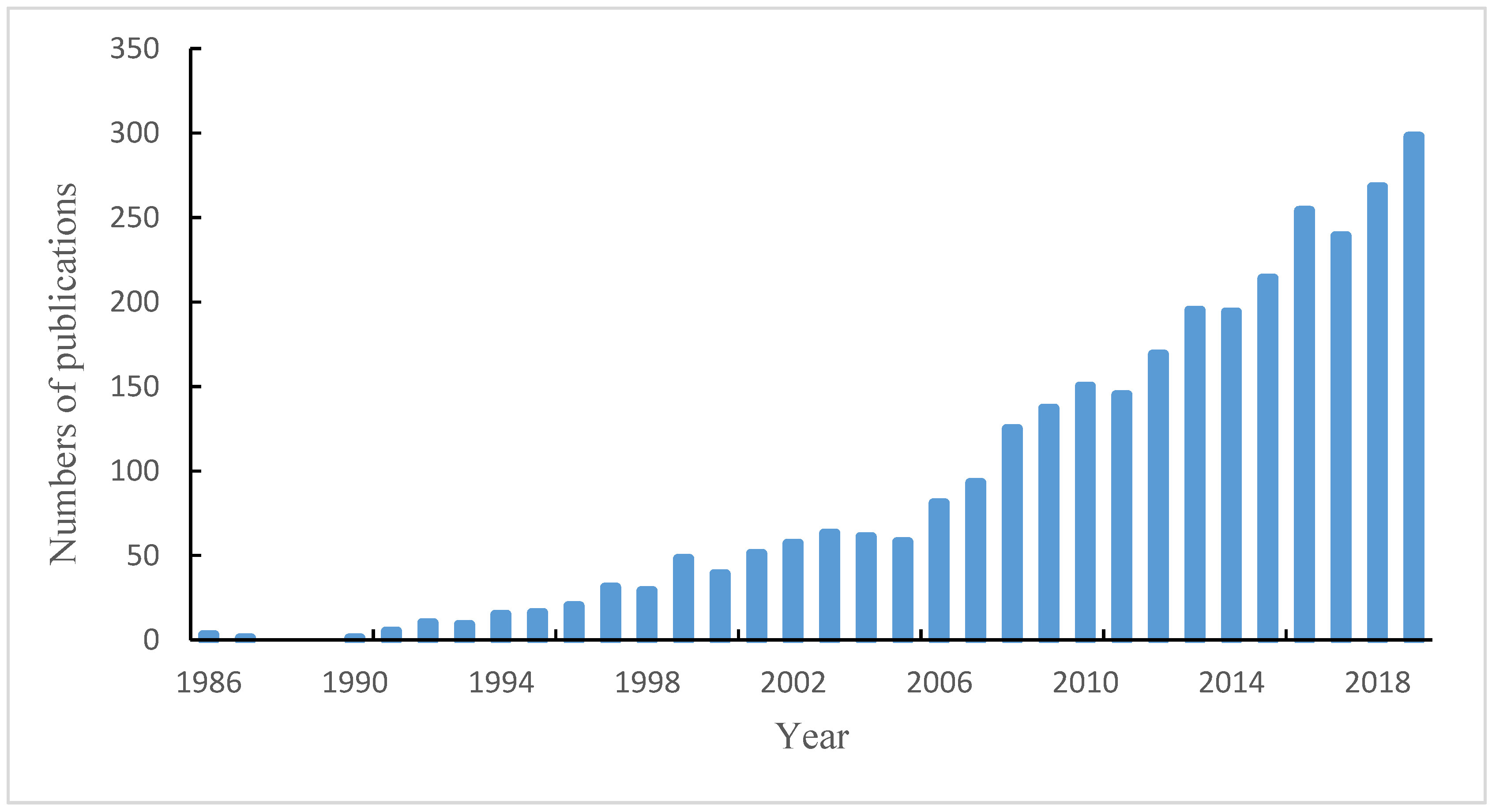
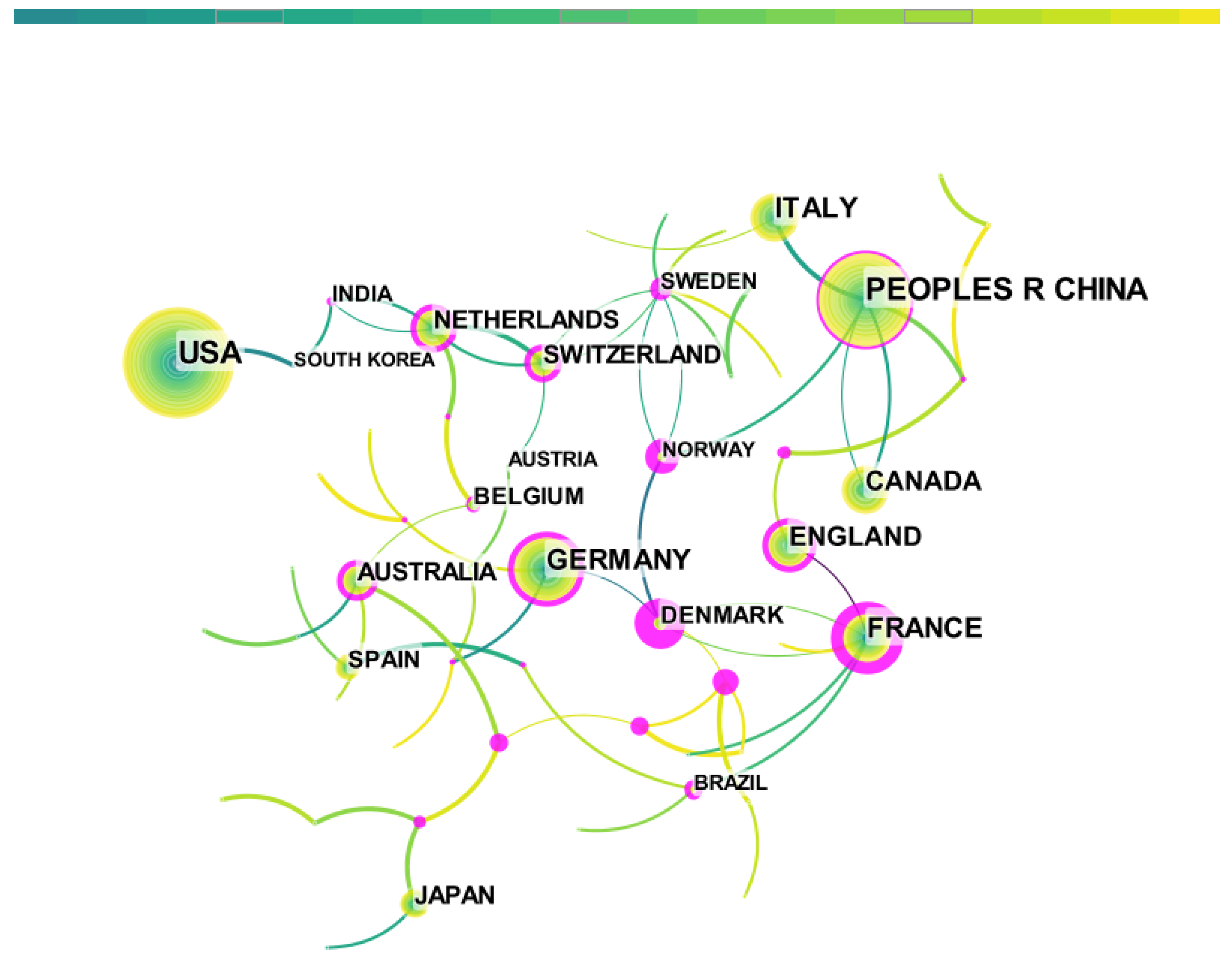
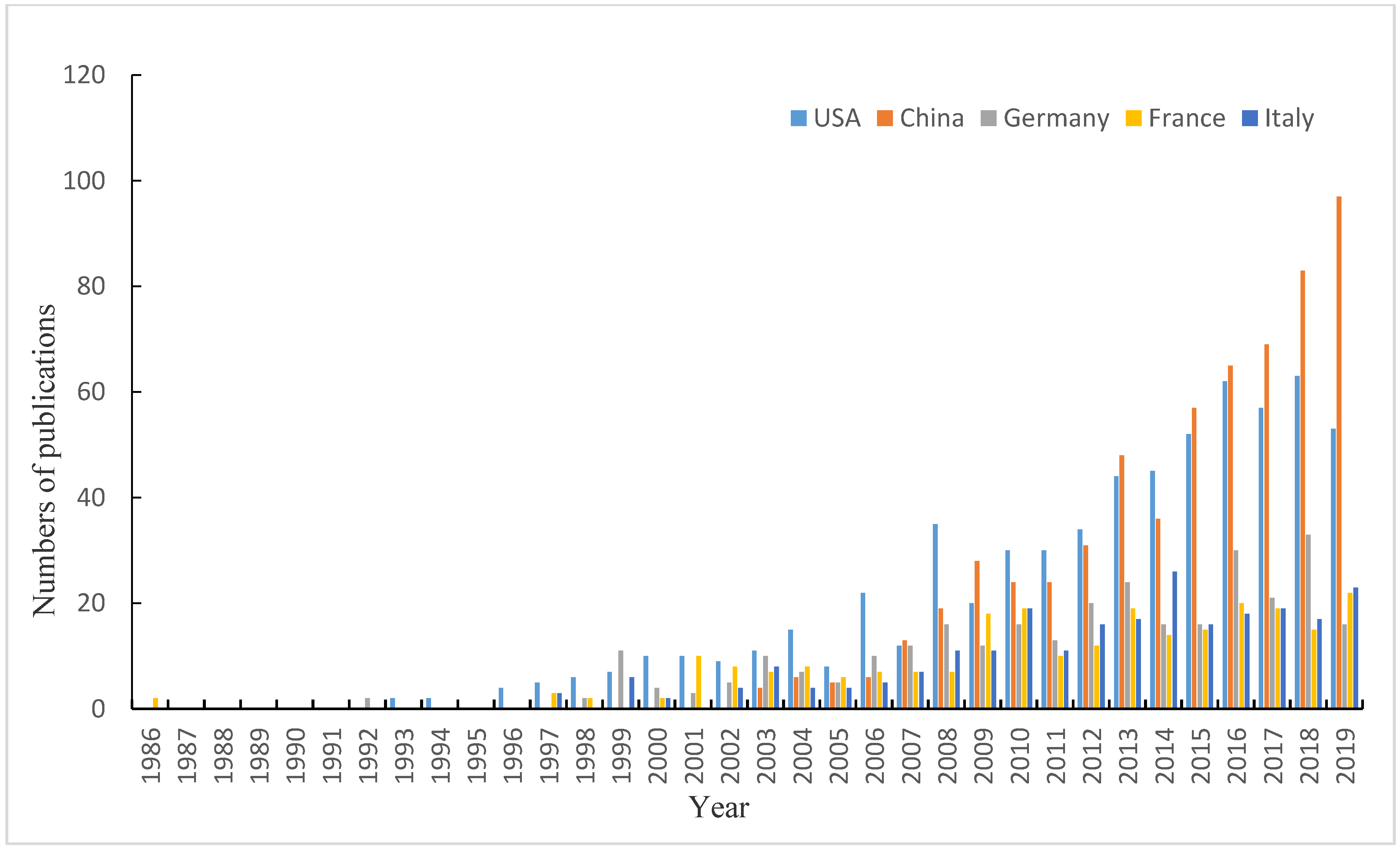
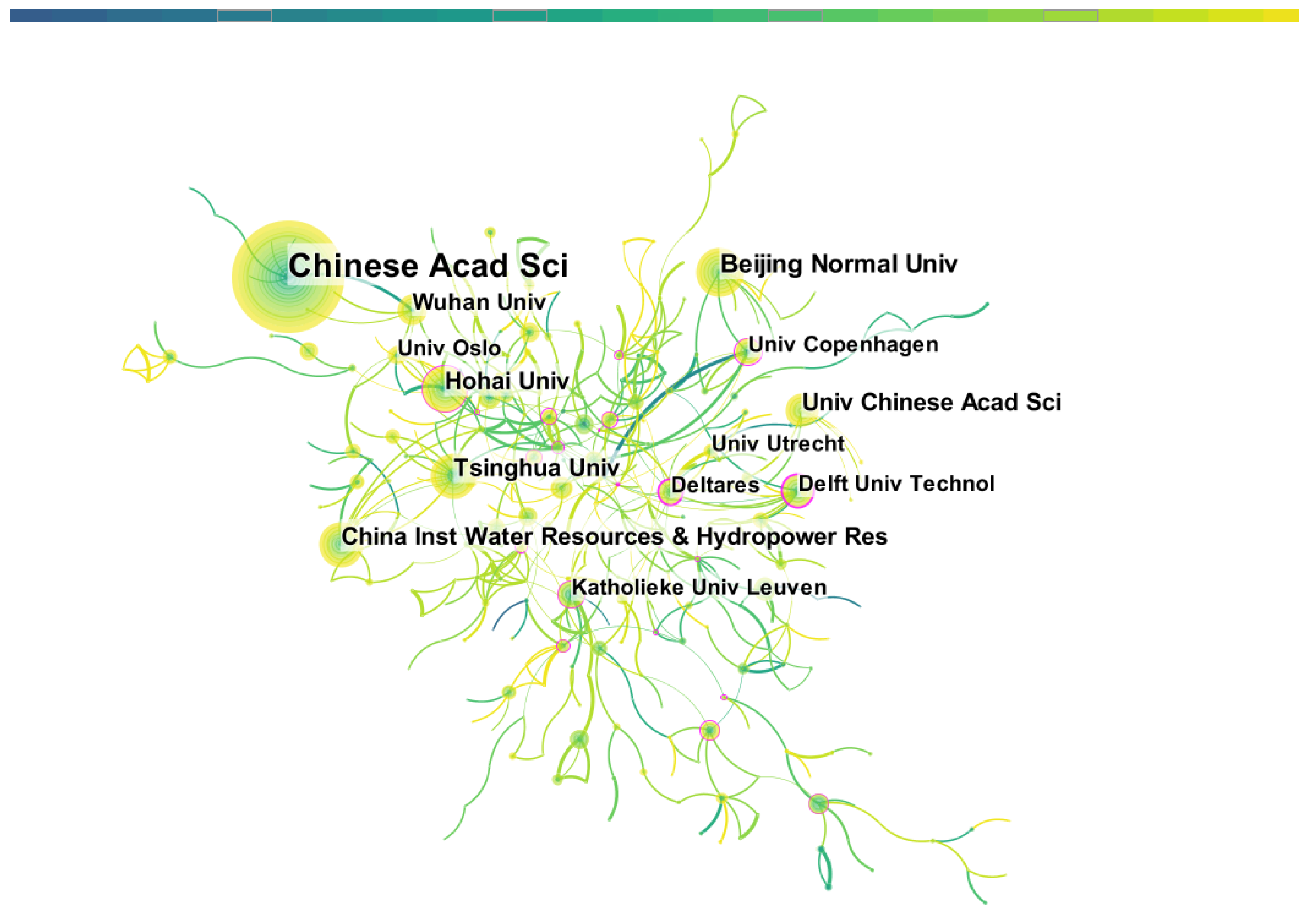

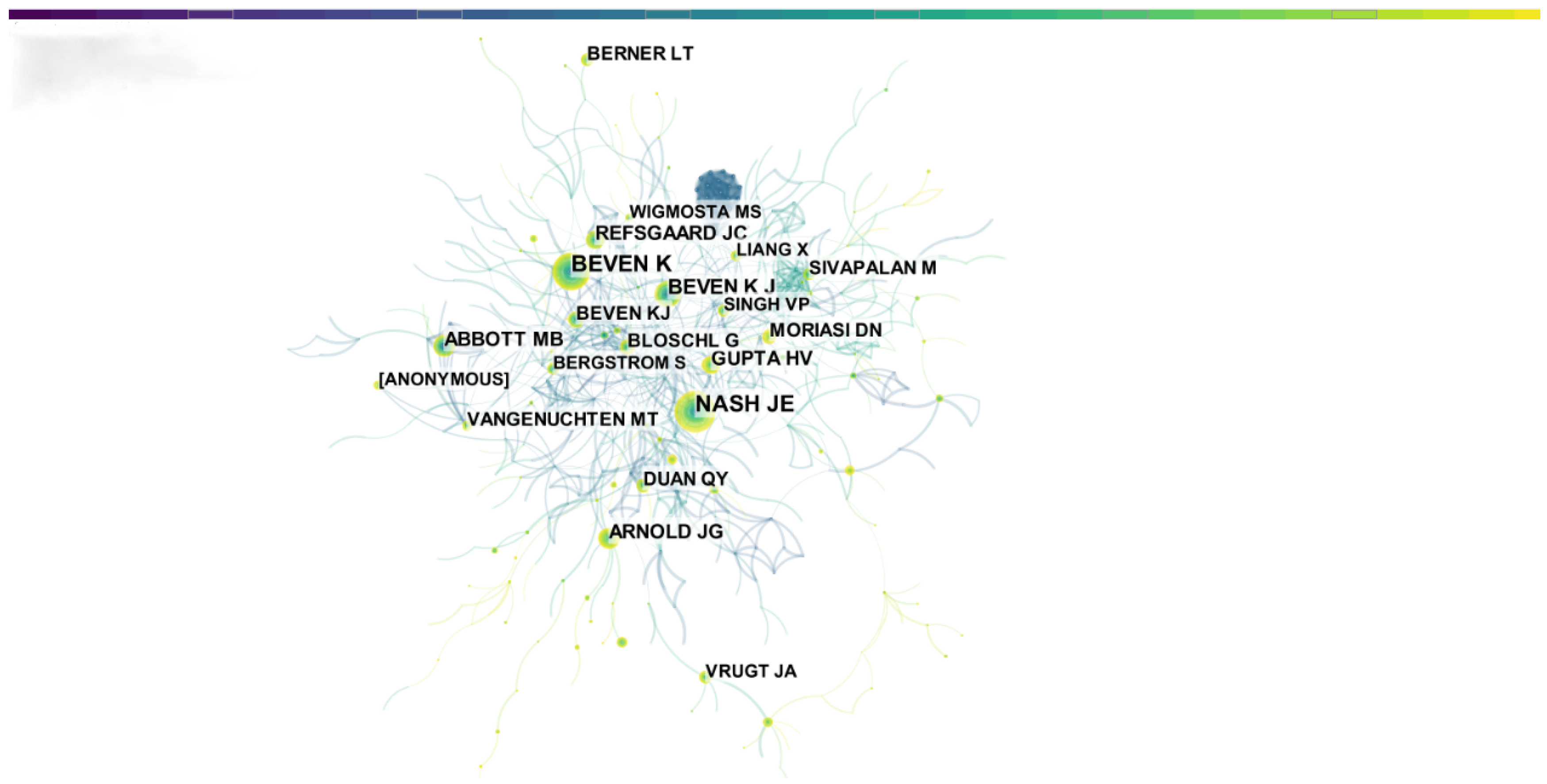
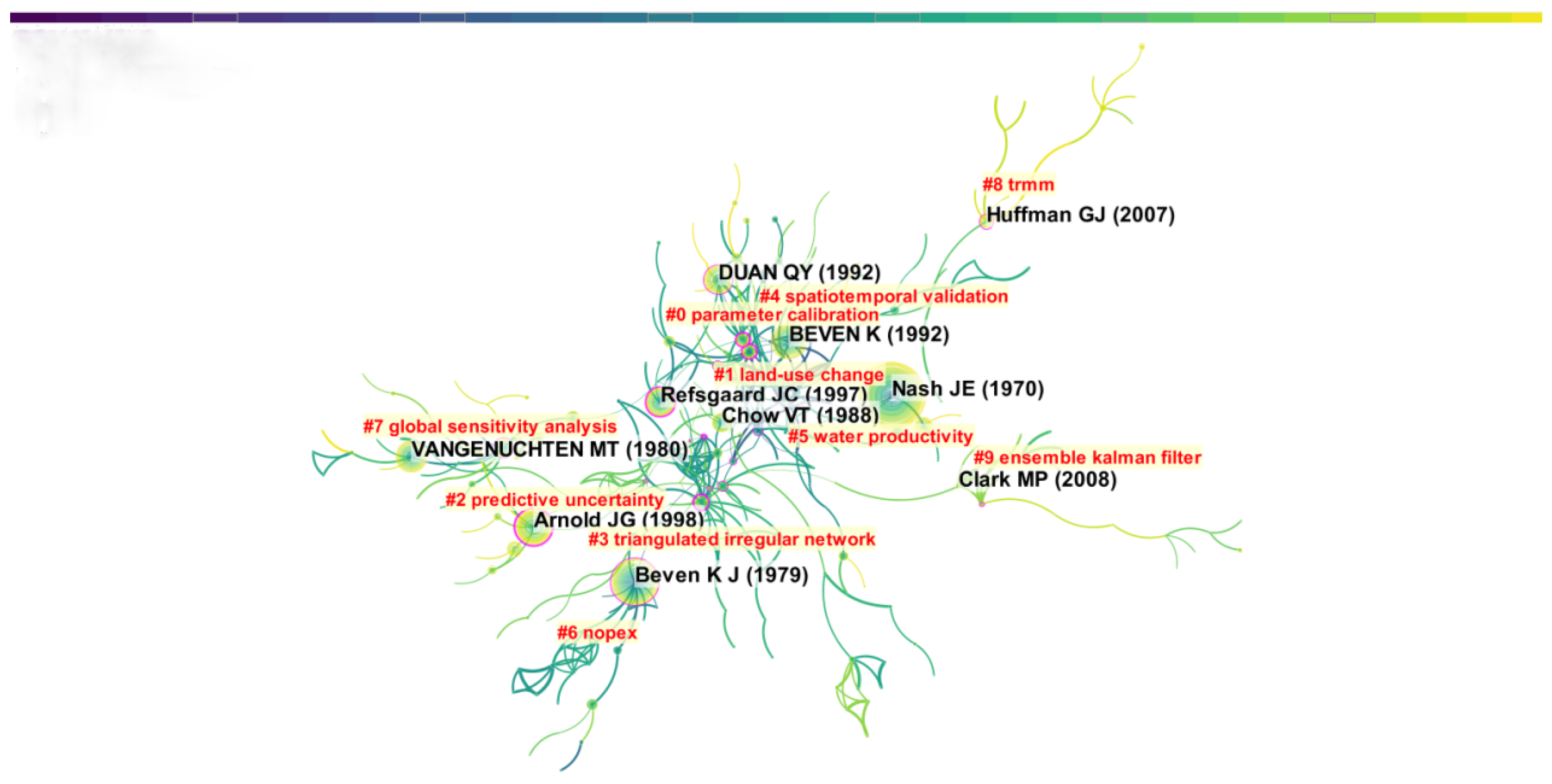

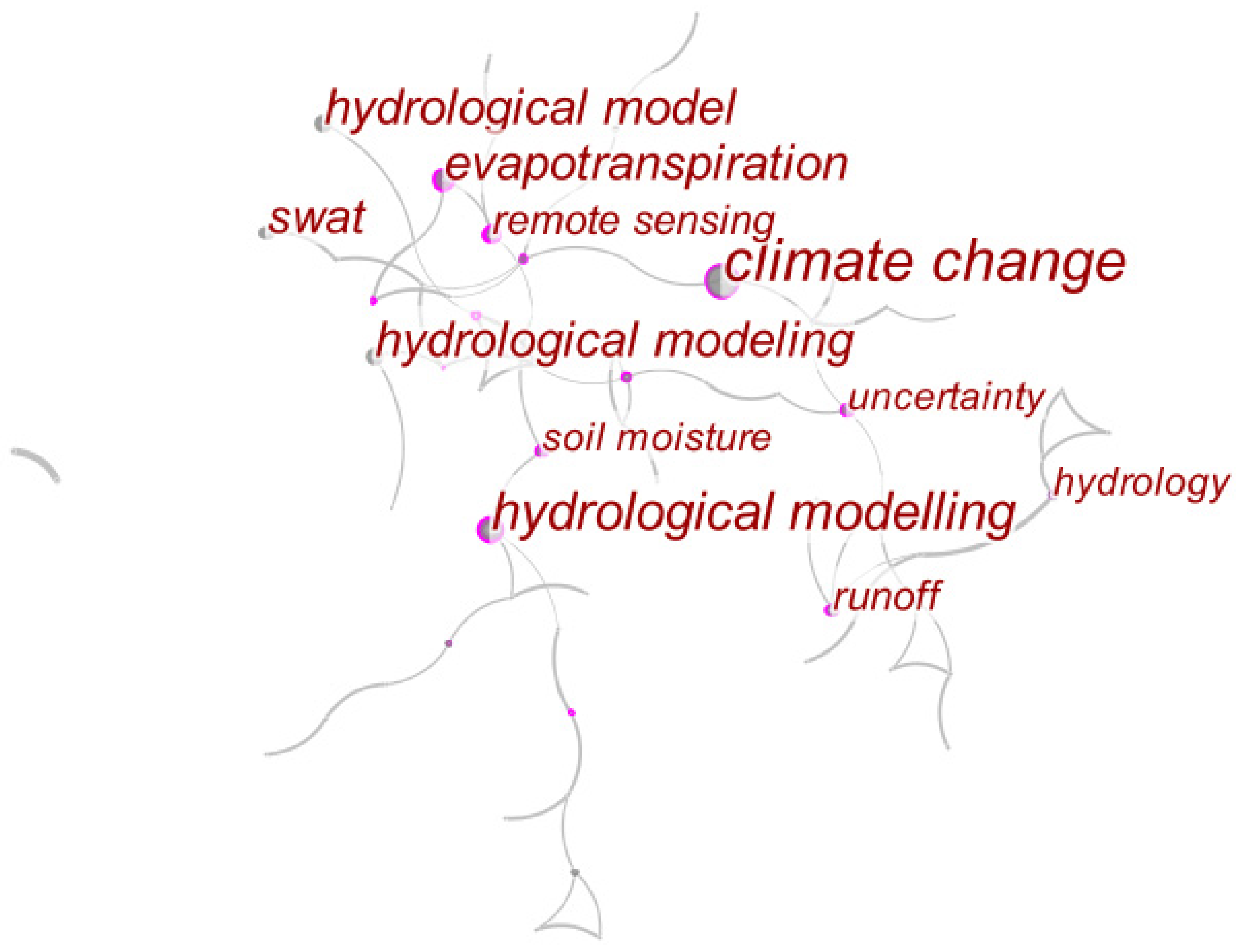
| Ranking | Number of Articles Published | Institution |
|---|---|---|
| 1 | 197 | Chinese Acad Sci |
| 2 | 63 | Beijing Normal Univ |
| 3 | 56 | Hohai Univ |
| 4 | 54 | China Inst Water Resources & Hydropower Res |
| 5 | 54 | Tsinghua Univ |
| 6 | 52 | Univ Chinese Acad Sci |
| 7 | 38 | Wuhan Univ |
| 8 | 36 | Delft Univ Technol |
| 9 | 34 | Univ Copenhagen |
| 10 | 34 | Katholieke Univ Leuven |
| Cluster ID | Size | Silhouette | Mean Year | Representative Terms (LLR) |
|---|---|---|---|---|
| 0 | 35 | 0.934 | 2000 | Parameter calibration |
| 1 | 35 | 0.889 | 1997 | Land-use change |
| 2 | 34 | 0.930 | 2002 | Predictive uncertainty |
| 3 | 32 | 0.848 | 1995 | Triangulated irregular network |
| 4 | 30 | 0.951 | 1993 | Spatiotemporal validation |
| 5 | 27 | 0.931 | 2000 | Water productivity |
| 6 | 24 | 0.965 | 1989 | NOrthern hemisphere climate Processes land surface EXperiment (NOPEX) |
| 7 | 22 | 0.899 | 1996 | Global sensitivity analysis |
| 8 | 21 | 1 | 2009 | Tropical Rainfall Measuring Mission (TRMM) |
| 9 | 20 | 0.965 | 2006 | Ensemble Kalman filter |
| Ranking | Journal | First Author | Title |
|---|---|---|---|
| 1 | Journal of Hydrology | J.E. Nash | River flow forecasting through conceptual models, part I—A discussion of principles |
| 2 | Water Resources Research | Mark S. Wigmosta | A distributed hydrology vegetation model for complex terrain |
| 3 | Transactions of the ASABE | D.N. Moriasi | Model Evaluation Guidelines for Systematic Quantification of Accuracy in Watershed Simulations |
| 4 | Journal of the American Water Resources Association | J.G. Arnold | Large Area Hydrologic Modeling and Assessment, Part I: Model Development |
| 5 | Hydrological Processes | K. Beven | The future of distributed models: Model calibration and uncertainty prediction |
| 6 | Biogeosciences | L.T. Berner | Cajander larch (Larix cajanderi) biomass distribution, fire regime and post-fire recovery in northeastern Siberia |
| 7 | Journal of Hydrology | M.B. Abbott | An introduction to the European Hydrological System—Système Hydrologique Européen, “SHE”, 2: Structure of a physically-based, distributed modelling system |
| 8 | Soil Science Society of America Journal | M. Th. van Genuchten | A Closed form Equation for Predicting the Hydraulic Conductivity of Unsaturated Soils |
| 9 | Journal of Hydrology | M.B. Abbott | An introduction to the European Hydrological System—Système Hydrologique Européen, “SHE”, 1: History and philosophy of a physically-based, distributed modelling system |
| 10 | Water Resources Research | Qingyun Duan | Effective and efficient global optimization for conceptual rainfall-runoff models |
| Cluster ID | Size | Silhouette | Mean Year | Lable (LLR) |
|---|---|---|---|---|
| 0 | 37 | 0.985 | 2013 | Uncertainty analysis |
| 1 | 37 | 0.884 | 2009 | Surface runoff |
| 2 | 34 | 0.891 | 2009 | Streamflow |
| 3 | 28 | 0.934 | 2013 | Great Lakes |
| 4 | 26 | 0.929 | 2011 | Hydrologic models |
| 5 | 25 | 0.919 | 2010 | Hydrological processes |
| 6 | 23 | 0.959 | 2013 | Optimization |
| 7 | 22 | 0.925 | 2010 | CEQUEAU (model) |
| 8 | 20 | 0.934 | 2011 | Spatial distribution |
| 9 | 20 | 0.937 | 2013 | Gravity Recovery and Climate Experiment |
| Keywords | Year | Strength | Begin | End | 1986–2019 |
|---|---|---|---|---|---|
| distributed modeling | 1986 | 3.5443 | 1995 | 2005 | ▂▂▂▂▂▂▂▂▂▃▃▃▃▃▃▃▃▃▃▃▂▂▂▂▂▂▂▂▂▂▂▂▂▂ |
| hydrological model | 1986 | 3.0914 | 1995 | 2000 | ▂▂▂▂▂▂▂▂▂▃▃▃▃▃▃▂▂▂▂▂▂▂▂▂▂▂▂▂▂▂▂▂▂▂ |
| aggregation | 1986 | 4.2414 | 1995 | 2004 | ▂▂▂▂▂▂▂▂▂▃▃▃▃▃▃▃▃▃▃▂▂▂▂▂▂▂▂▂▂▂▂▂▂▂ |
| topmodel | 1986 | 4.7137 | 1997 | 2004 | ▂▂▂▂▂▂▂▂▂▂▂▃▃▃▃▃▃▃▃▂▂▂▂▂▂▂▂▂▂▂▂▂▂▂ |
| runoff | 1986 | 6.1307 | 1997 | 2008 | ▂▂▂▂▂▂▂▂▂▂▂▃▃▃▃▃▃▃▃▃▃▃▃▂▂▂▂▂▂▂▂▂▂▂ |
| simulation | 1986 | 2.8983 | 1999 | 2007 | ▂▂▂▂▂▂▂▂▂▂▂▂▂▃▃▃▃▃▃▃▃▃▂▂▂▂▂▂▂▂▂▂▂▂ |
| disaggregation | 1986 | 2.7104 | 1999 | 2000 | ▂▂▂▂▂▂▂▂▂▂▂▂▂▃▃▂▂▂▂▂▂▂▂▂▂▂▂▂▂▂▂▂▂▂ |
| evapotranspiration | 1986 | 3.0497 | 1999 | 2000 | ▂▂▂▂▂▂▂▂▂▂▂▂▂▃▃▂▂▂▂▂▂▂▂▂▂▂▂▂▂▂▂▂▂▂ |
| mountain hydrology | 1986 | 3.1009 | 1999 | 2008 | ▂▂▂▂▂▂▂▂▂▂▂▂▂▃▃▃▃▃▃▃▃▃▃▂▂▂▂▂▂▂▂▂▂▂ |
| distributed modelling | 1986 | 3.5973 | 1999 | 2007 | ▂▂▂▂▂▂▂▂▂▂▂▂▂▃▃▃▃▃▃▃▃▃▂▂▂▂▂▂▂▂▂▂▂▂ |
| distributed hydrological modelling | 1986 | 4.0156 | 2001 | 2004 | ▂▂▂▂▂▂▂▂▂▂▂▂▂▂▂▃▃▃▃▂▂▂▂▂▂▂▂▂▂▂▂▂▂▂ |
| hydrology | 1986 | 4.6525 | 2001 | 2005 | ▂▂▂▂▂▂▂▂▂▂▂▂▂▂▂▃▃▃▃▃▂▂▂▂▂▂▂▂▂▂▂▂▂▂ |
| distributedmodel | 1986 | 2.5531 | 2001 | 2007 | ▂▂▂▂▂▂▂▂▂▂▂▂▂▂▂▃▃▃▃▃▃▃▂▂▂▂▂▂▂▂▂▂▂▂ |
| sensitivity analysis | 1986 | 2.3495 | 2002 | 2005 | ▂▂▂▂▂▂▂▂▂▂▂▂▂▂▂▂▃▃▃▃▂▂▂▂▂▂▂▂▂▂▂▂▂▂ |
| hydrological modelling | 1986 | 3.5999 | 2002 | 2007 | ▂▂▂▂▂▂▂▂▂▂▂▂▂▂▂▂▃▃▃▃▃▃▂▂▂▂▂▂▂▂▂▂▂▂ |
| distributed model | 1986 | 7.5845 | 2002 | 2012 | ▂▂▂▂▂▂▂▂▂▂▂▂▂▂▂▂▃▃▃▃▃▃▃▃▃▃▃▂▂▂▂▂▂▂ |
| flood | 1986 | 2.9424 | 2002 | 2004 | ▂▂▂▂▂▂▂▂▂▂▂▂▂▂▂▂▃▃▃▂▂▂▂▂▂▂▂▂▂▂▂▂▂▂ |
| runoff generation | 1986 | 3.863 | 2003 | 2004 | ▂▂▂▂▂▂▂▂▂▂▂▂▂▂▂▂▂▃▃▂▂▂▂▂▂▂▂▂▂▂▂▂▂▂ |
| gis | 1986 | 5.6917 | 2003 | 2010 | ▂▂▂▂▂▂▂▂▂▂▂▂▂▂▂▂▂▃▃▃▃▃▃▃▃▂▂▂▂▂▂▂▂▂ |
| distributed hydrological model | 1986 | 3.3624 | 2004 | 2007 | ▂▂▂▂▂▂▂▂▂▂▂▂▂▂▂▂▂▂▃▃▃▃▂▂▂▂▂▂▂▂▂▂▂▂ |
| automatic calibration | 1986 | 2.3024 | 2004 | 2008 | ▂▂▂▂▂▂▂▂▂▂▂▂▂▂▂▂▂▂▃▃▃▃▃▂▂▂▂▂▂▂▂▂▂▂ |
| digital elevation model | 1986 | 3.0792 | 2004 | 2009 | ▂▂▂▂▂▂▂▂▂▂▂▂▂▂▂▂▂▂▃▃▃▃▃▃▂▂▂▂▂▂▂▂▂▂ |
| snowmelt | 1986 | 5.3009 | 2004 | 2008 | ▂▂▂▂▂▂▂▂▂▂▂▂▂▂▂▂▂▂▃▃▃▃▃▂▂▂▂▂▂▂▂▂▂▂ |
| rainfall-runoff model | 1986 | 3.0973 | 2005 | 2011 | ▂▂▂▂▂▂▂▂▂▂▂▂▂▂▂▂▂▂▂▃▃▃▃▃▃▃▂▂▂▂▂▂▂▂ |
| flood prediction | 1986 | 2.5032 | 2005 | 2007 | ▂▂▂▂▂▂▂▂▂▂▂▂▂▂▂▂▂▂▂▃▃▃▂▂▂▂▂▂▂▂▂▂▂▂ |
| water balance | 1986 | 2.6727 | 2006 | 2008 | ▂▂▂▂▂▂▂▂▂▂▂▂▂▂▂▂▂▂▂▂▃▃▃▂▂▂▂▂▂▂▂▂▂▂ |
| modelling | 1986 | 4.8293 | 2006 | 2008 | ▂▂▂▂▂▂▂▂▂▂▂▂▂▂▂▂▂▂▂▂▃▃▃▂▂▂▂▂▂▂▂▂▂▂ |
| calibration | 1986 | 2.2889 | 2007 | 2008 | ▂▂▂▂▂▂▂▂▂▂▂▂▂▂▂▂▂▂▂▂▂▃▃▂▂▂▂▂▂▂▂▂▂▂ |
| regional climate model | 1986 | 2.158 | 2007 | 2009 | ▂▂▂▂▂▂▂▂▂▂▂▂▂▂▂▂▂▂▂▂▂▃▃▃▂▂▂▂▂▂▂▂▂▂ |
| wetland | 1986 | 3.6104 | 2009 | 2011 | ▂▂▂▂▂▂▂▂▂▂▂▂▂▂▂▂▂▂▂▂▂▂▂▃▃▃▂▂▂▂▂▂▂▂ |
| groundwater recharge | 1986 | 4.1903 | 2009 | 2013 | ▂▂▂▂▂▂▂▂▂▂▂▂▂▂▂▂▂▂▂▂▂▂▂▃▃▃▃▃▂▂▂▂▂▂ |
| weather radar | 1986 | 2.1681 | 2009 | 2015 | ▂▂▂▂▂▂▂▂▂▂▂▂▂▂▂▂▂▂▂▂▂▂▂▃▃▃▃▃▃▃▂▂▂▂ |
| pcraster | 1986 | 2.3827 | 2009 | 2010 | ▂▂▂▂▂▂▂▂▂▂▂▂▂▂▂▂▂▂▂▂▂▂▂▃▃▂▂▂▂▂▂▂▂▂ |
| hydraulic model | 1986 | 2.3684 | 2011 | 2012 | ▂▂▂▂▂▂▂▂▂▂▂▂▂▂▂▂▂▂▂▂▂▂▂▂▂▃▃▂▂▂▂▂▂▂ |
| climate change | 1986 | 4.2772 | 2011 | 2012 | ▂▂▂▂▂▂▂▂▂▂▂▂▂▂▂▂▂▂▂▂▂▂▂▂▂▃▃▂▂▂▂▂▂▂ |
| river basin | 1986 | 3.3518 | 2012 | 2013 | ▂▂▂▂▂▂▂▂▂▂▂▂▂▂▂▂▂▂▂▂▂▂▂▂▂▂▃▃▂▂▂▂▂▂ |
| wetspa | 1986 | 2.9464 | 2012 | 2013 | ▂▂▂▂▂▂▂▂▂▂▂▂▂▂▂▂▂▂▂▂▂▂▂▂▂▂▃▃▂▂▂▂▂▂ |
| spatial discretization | 1986 | 2.1936 | 2013 | 2014 | ▂▂▂▂▂▂▂▂▂▂▂▂▂▂▂▂▂▂▂▂▂▂▂▂▂▂▂▃▃▂▂▂▂▂ |
| surface runoff | 1986 | 2.4468 | 2013 | 2016 | ▂▂▂▂▂▂▂▂▂▂▂▂▂▂▂▂▂▂▂▂▂▂▂▂▂▂▂▃▃▃▃▂▂▂ |
| china | 1986 | 3.5548 | 2013 | 2014 | ▂▂▂▂▂▂▂▂▂▂▂▂▂▂▂▂▂▂▂▂▂▂▂▂▂▂▂▃▃▂▂▂▂▂ |
| copula | 1986 | 2.1884 | 2014 | 2015 | ▂▂▂▂▂▂▂▂▂▂▂▂▂▂▂▂▂▂▂▂▂▂▂▂▂▂▂▂▃▃▂▂▂▂ |
| flash flood | 1986 | 2.6689 | 2014 | 2016 | ▂▂▂▂▂▂▂▂▂▂▂▂▂▂▂▂▂▂▂▂▂▂▂▂▂▂▂▂▃▃▃▂▂▂ |
| hydrologic model | 1986 | 4.2868 | 2014 | 2015 | ▂▂▂▂▂▂▂▂▂▂▂▂▂▂▂▂▂▂▂▂▂▂▂▂▂▂▂▂▃▃▂▂▂▂ |
| data assimilation | 1986 | 3.1799 | 2014 | 2017 | ▂▂▂▂▂▂▂▂▂▂▂▂▂▂▂▂▂▂▂▂▂▂▂▂▂▂▂▂▃▃▃▃▂▂ |
| uncertainty analysis | 1986 | 3.1744 | 2014 | 2016 | ▂▂▂▂▂▂▂▂▂▂▂▂▂▂▂▂▂▂▂▂▂▂▂▂▂▂▂▂▃▃▃▂▂▂ |
| swat model | 1986 | 2.4835 | 2015 | 2019 | ▂▂▂▂▂▂▂▂▂▂▂▂▂▂▂▂▂▂▂▂▂▂▂▂▂▂▂▂▂▃▃▃▃▃ |
| trmm | 1986 | 2.3384 | 2016 | 2019 | ▂▂▂▂▂▂▂▂▂▂▂▂▂▂▂▂▂▂▂▂▂▂▂▂▂▂▂▂▂▂▃▃▃▃ |
| downscaling | 1986 | 2.4475 | 2016 | 2019 | ▂▂▂▂▂▂▂▂▂▂▂▂▂▂▂▂▂▂▂▂▂▂▂▂▂▂▂▂▂▂▃▃▃▃ |
| dhsvm | 1986 | 4.1772 | 2016 | 2017 | ▂▂▂▂▂▂▂▂▂▂▂▂▂▂▂▂▂▂▂▂▂▂▂▂▂▂▂▂▂▂▃▃▂▂ |
| hydrologicalmodelling | 1986 | 2.9837 | 2016 | 2019 | ▂▂▂▂▂▂▂▂▂▂▂▂▂▂▂▂▂▂▂▂▂▂▂▂▂▂▂▂▂▂▃▃▃▃ |
| precipitation | 1986 | 3.7723 | 2017 | 2019 | ▂▂▂▂▂▂▂▂▂▂▂▂▂▂▂▂▂▂▂▂▂▂▂▂▂▂▂▂▂▂▂▃▃▃ |
| bias correction | 1986 | 2.3754 | 2017 | 2019 | ▂▂▂▂▂▂▂▂▂▂▂▂▂▂▂▂▂▂▂▂▂▂▂▂▂▂▂▂▂▂▂▃▃▃ |
Publisher’s Note: MDPI stays neutral with regard to jurisdictional claims in published maps and institutional affiliations. |
© 2021 by the authors. Licensee MDPI, Basel, Switzerland. This article is an open access article distributed under the terms and conditions of the Creative Commons Attribution (CC BY) license (http://creativecommons.org/licenses/by/4.0/).
Share and Cite
Qin, F.; Zhu, Y.; Ao, T.; Chen, T. The Development Trend and Research Frontiers of Distributed Hydrological Models—Visual Bibliometric Analysis Based on Citespace. Water 2021, 13, 174. https://doi.org/10.3390/w13020174
Qin F, Zhu Y, Ao T, Chen T. The Development Trend and Research Frontiers of Distributed Hydrological Models—Visual Bibliometric Analysis Based on Citespace. Water. 2021; 13(2):174. https://doi.org/10.3390/w13020174
Chicago/Turabian StyleQin, Fangling, Ying Zhu, Tianqi Ao, and Ting Chen. 2021. "The Development Trend and Research Frontiers of Distributed Hydrological Models—Visual Bibliometric Analysis Based on Citespace" Water 13, no. 2: 174. https://doi.org/10.3390/w13020174
APA StyleQin, F., Zhu, Y., Ao, T., & Chen, T. (2021). The Development Trend and Research Frontiers of Distributed Hydrological Models—Visual Bibliometric Analysis Based on Citespace. Water, 13(2), 174. https://doi.org/10.3390/w13020174





